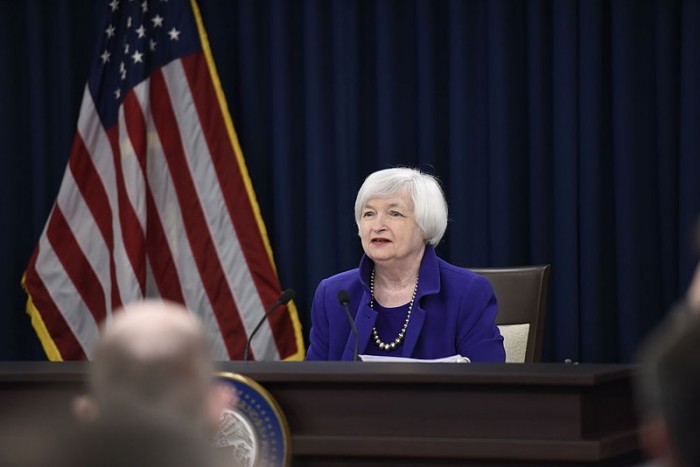(BubbleOrNot) Federal Reserve Chairperson Janet Yellen was recently asked if she was comfortable with the Dow approaching 20,000. She replied “Rates of return in the stock market relative to – remember that the level of interest rates is low – and taking that into account. I believe it’s fair to say that they remain within normal ranges.”
Janet Yellen is not the first person to claim that high stock market valuations are normal when interest rates are low. In theory owners of stocks expect a risk premium over the risk-free rate available to holders of government bonds. When the risk-free rate is itself zero, the yield on equities will be nothing more than the risk premium, and a low yield on equities translates into a high price earnings ratio.
Let’s take a look at this idea more closely. First consider the high equity valuations as demonstrated by Robert Shiller’s Cyclically Adjusted PE Ratio. This is the price of a stock divided by the average of the last ten years of inflation-adjusted earnings. For the S&P 500, CAPE recently hit 28, a valuation only surpassed right before the 1929 crash and in the build-up to the dotcom crash.

Chart 1
source: http://www.multpl.com/shiller-pe/
It looks a little worrying, but it’s not a big deal because interest rates are low, right?
Here are some monthly interest rate data I downloaded from the Fed.

Chart 2
source: 3-month Treasury bill secondary market rate discount basis
H.15 Release–Selected Interest Rates–Historical Data
https://www.federalreserve.gov/datadownload/Choose.aspx?rel=H15
Moody’s Seasoned Aaa Corporate Bond Yield© (DISCONTINUED)
https://fred.stlouisfed.org/tags/series?t=interest+rate%3Bmonthly%3Busa
The T-Bill data are from Jan 1934 to Nov 2016. The AAA Corporate bond yields are from Jan 1919 to Sep 2016. I included the corporate bond yields, since it might be the risk premium of stocks over corporate bond yields that is more relevant to the Yellen theory of high PE ratios.
Following the logic of this theory, I decide to adjust (or “normalize”) the monthly CAPE values by multiplying them by historical interest rates.

Chart 3
Look at that! The scary CAPE value of 27.92 was originally in the 94th percentile. But after adjusting it by the current AAA bond yield of 3.77, now it’s only in the 59th percentile. And if we adjust it instead by the current 3 month T-Bill rate of 0.47, now it’s in the 30th percentile.
Unfortunately, there may be a flaw with this theory. If you look at Chart 2 you will see that there was a similar period of low interest rates from 1934 to 1946. But we don’t have an elevated CAPE during this period of low interest rates. There was just a brief spike up to 23.

mean: 13.6 std dev: 3.1
Of course the country was dealing with the Great Depression and the Second World War during this period. So one could argue that this is not a comparable period.
What if we examine the relationship between interest rates and CAPE for the full historical periods for which we have data?


Two things to note about these scatterplots.
All CAPE values above 30 occurred during the dotcom mania,
and all interest rates above 12 occurred in proximity to the 1980 interest rate spike.


In both cases (AAA and T-Bills) there is a statistically significant negative linear relationship between CAPE and interest rates. But the R-squared values are only 1% and 3%. We must conclude that CAPE values are explained almost entirely by factors other than a low interest rate in the concurrent month.
No, I don’t think a CAPE of 28 is normal when interest rates are low. I would describe a CAPE of 28 as abnormally high. If you exclude the dotcom mania, 28 is extreme. However, one must admit that a CAPE of 28 is to be expected at the tail end of eight years of TARP, TBTF, ZIRP, QE123, PPT, central bank coordination, and HFT.
